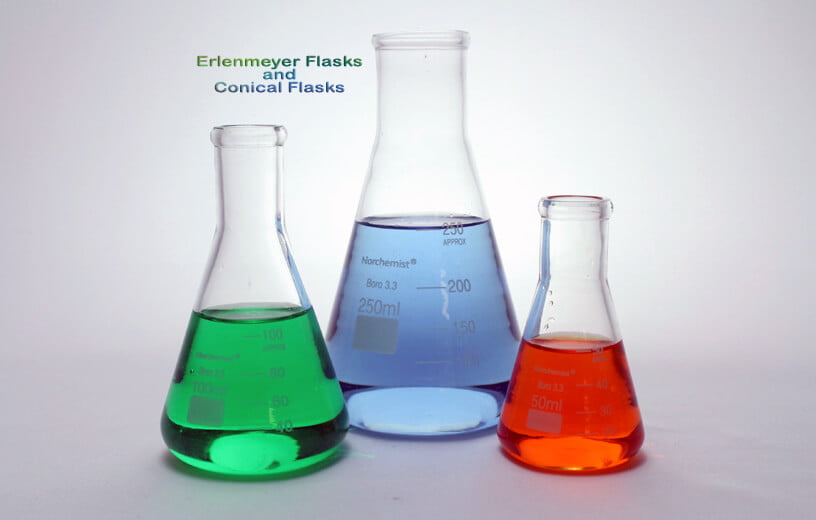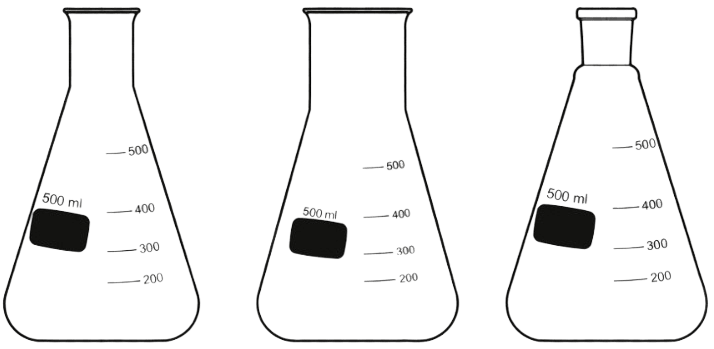- Water Testing Meters
- Anemometer
- Length & Distance Meter
- Multimeter & Clamp Meter
- Light and Sound Meter
- Slide Calipers & Screw Gauge
- Thermometer & Hygrometer
- Milk Testing Meters
- Paper, Grain & Wood Testers
- Stopwatch & Timers
- Soil Testing Meters
- Refractometers & Analyzer
- Magnetic Compass
- Tachometer & Megger
- Thickness & Dia-Meters
- Other Meter And Accessories
Exploring the Versatility of Erlenmeyer Flasks and Conical Flasks

Laboratory glassware comes in various shapes and sizes, each designed for specific purposes and applications. Among the most versatile and commonly used pieces are Erlenmeyer flasks and conical flasks. These iconic vessels have distinct shapes that make them indispensable tools in scientific research, experimentation, and analysis. In this extensive exploration, we delve into the unique features, uses, and significance of Erlenmeyer flasks and conical flasks in the realm of science and beyond.

Understanding Erlenmeyer Flasks
Erlenmeyer flasks, named after the German chemist Emil Erlenmeyer, are characterized by their conical shape with a flat bottom and a narrow neck. This design allows for easy swirling and mixing of liquids without the risk of spills or splashes. The narrow neck also minimizes evaporation and facilitates the use of stoppers or caps for sealing purposes. Erlenmeyer flasks are typically made of borosilicate glass, which is resistant to thermal shock and chemical corrosion, making them suitable for a wide range of laboratory applications.
Uses of Erlenmeyer Flasks
- Mixing and Stirring: Erlenmeyer flasks are commonly used for mixing and stirring solutions due to their conical shape, which promotes efficient mixing without the need for excessive agitation.
- Titration: The narrow neck of Erlenmeyer flasks makes them ideal for conducting titration experiments, where precise control over the addition of reagents is essential.
- Culturing Microorganisms: Erlenmeyer flasks are often used in microbiology for culturing bacteria, yeast, and other microorganisms. The wide base provides ample surface area for cell growth, while the narrow neck helps prevent contamination and allows for gas exchange.
- Heating and Boiling: Erlenmeyer flasks can be used for heating and boiling liquids over a Bunsen burner or hot plate. The flat bottom ensures uniform heat distribution, while the tapered shape minimizes the risk of boiling over.
- Solvent Extraction: Erlenmeyer flasks are commonly employed in solvent extraction procedures, where organic compounds are extracted from aqueous solutions or vice versa. The conical shape allows for efficient phase separation, with the organic layer accumulating at the bottom for easy recovery.
Exploring Conical Flasks
Conical flasks, also known as Erlenmeyer flasks with a round bottom, share many similarities with their flat-bottomed counterparts but have a rounded or spherical bottom instead of a flat one. This design allows conical flasks to be placed on surfaces without the need for additional support, making them ideal for applications where stability is crucial.
Uses of Conical Flasks
- Storage and Transport: Conical flasks are commonly used for storing and transporting liquids, solutions, and samples. The rounded bottom provides stability, while the narrow neck allows for easy pouring and decanting.
- Filtration: Conical flasks are often used in filtration setups, such as vacuum filtration or gravity filtration, where the filtrate needs to be collected in a container. The wide base of the flask accommodates filter paper or membranes, while the narrow neck ensures a secure fit with the filtration apparatus.
- Solution Preparation: Conical flasks are suitable for preparing and diluting solutions due to their large capacity and stable design. The rounded bottom allows for efficient mixing and swirling of liquids, while the narrow neck facilitates accurate measurement and dispensing of reagents.
- Chemical Reactions: Conical flasks can be used for conducting chemical reactions that require gentle heating or refluxing. The rounded bottom ensures uniform heating and prevents hot spots, while the narrow neck allows for the attachment of reflux condensers or other accessories.
- Yeast Propagation: Conical flasks are commonly used in the propagation of yeast cultures for brewing and fermentation processes. The rounded bottom provides ample surface area for yeast growth, while the narrow neck minimizes the risk of contamination during inoculation and fermentation.
Differences between Erlenmeyer flasks and conical flasks
Erlenmeyer flasks and conical flasks are both common pieces of laboratory glassware, but they have distinct differences in their design, functionality, and applications. Here are some key differences between Erlenmeyer flasks and conical flasks:
Shape:
- Erlenmeyer Flask: Erlenmeyer flasks have a conical shape with a flat bottom and a narrow neck.
- Conical Flask: Conical flasks also have a conical shape but with a rounded or spherical bottom and a narrow neck.
Stability:
- Erlenmeyer Flask: Erlenmeyer flasks have a flat bottom, which may require additional support to prevent tipping over when placed on a flat surface.
- Conical Flask: Conical flasks have a rounded bottom, allowing them to stand on their own without additional support, providing greater stability.
Mixing and Stirring:
- Erlenmeyer Flask: The conical shape of Erlenmeyer flasks promotes efficient mixing and swirling of liquids without the risk of spills or splashes.
- Conical Flask: Conical flasks also facilitate the mixing and swirling of liquids but may offer slightly different mixing characteristics due to their rounded bottom.
Applications:
- Erlenmeyer Flask: Erlenmeyer flasks are commonly used for mixing, stirring, titration, culturing microorganisms, and heating liquids.
- Conical Flask: Conical flasks are often used for storage, transportation, filtration, solution preparation, and conducting chemical reactions.
Heating:
- Erlenmeyer Flask: Erlenmeyer flasks are suitable for heating and boiling liquids over a Bunsen burner or hot plate due to their flat bottom, which ensures uniform heat distribution.
- Conical Flask: Conical flasks can also be used for heating, but the rounded bottom may require additional care to prevent tipping over during heating.
Titration and Measurement:
- Erlenmeyer Flask: The narrow neck of Erlenmeyer flasks makes them ideal for conducting titration experiments, where precise control over the addition of reagents is essential.
- Conical Flask: Conical flasks can also be used for titration but may have slightly different pouring and measurement characteristics compared to Erlenmeyer flasks.
Space Utilization:
- Erlenmeyer Flask: Erlenmeyer flasks may be preferred in applications where space utilization is a concern due to their narrower profile.
- Conical Flask: Conical flasks may be preferred when stability and ease of handling are more important than space utilization due to their rounded bottom.
Comparison and Contrast
While Erlenmeyer flasks and conical flasks share similar functionalities and are often used interchangeably in laboratory settings, there are subtle differences between the two that make them suitable for specific applications. Erlenmeyer flasks, with their flat bottoms and narrow necks, are ideal for mixing, titration, and culturing microorganisms, while conical flasks, with their rounded bottoms, are better suited for storage, filtration, and solution preparation. However, both types of flasks offer versatility, durability, and practicality, making them indispensable tools in scientific research and experimentation.
Conclusion
Erlenmeyer flasks and conical flasks are essential components of any laboratory, educational institution, or industrial facility, providing scientists, researchers, and technicians with reliable and efficient vessels for a wide range of applications. Whether used for mixing solutions, culturing microorganisms, storing samples, or conducting chemical reactions, these iconic vessels play a vital role in advancing scientific knowledge and technological innovation. By understanding the unique features, uses, and significance of Erlenmeyer flasks and conical flasks, practitioners can maximize their effectiveness and efficiency in various laboratory procedures, contributing to advancements in science, medicine, and engineering.

